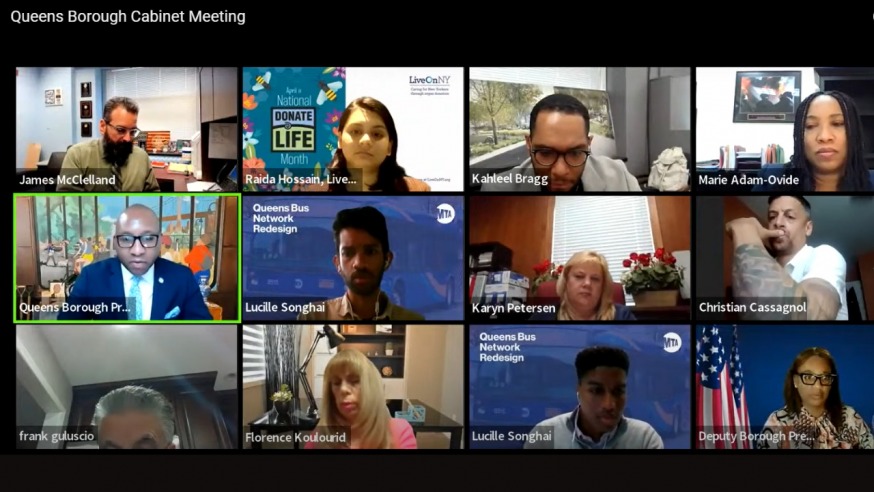
The MTA met virtually with the Queens Borough’s Office Tuesday and made a presentation about the agency’s plans to update the existing bus network in Queens (Photo: YouTube)
April 15, 2022 By Michael Dorgan
The MTA met virtually with the office of the Queens Borough President Tuesday and made a presentation about the agency’s plan to update the existing bus network in Queens.
The presentation gave an overview of the MTA’s revised draft bus plan that aims to overhaul the bus network across the borough in order to increase reliability and bus speeds. The system, which caters to about 800,000 average weekday riders, has largely been unchanged since the turn of the 20th century and many argue its service area also needs to be expanded.
In the meeting, the MTA said that it had taken feedback into account from community leaders and riders when crafting its latest designs. The agency was largely slammed by borough residents and officials when it came out with an initial draft plan in 2019. That plan was scrapped after the public panned it, since it called for the elimination and split of a number of bus lines that many deemed crucial components of the network.
MTA officials along with Queens Borough President Donovan Richards and members of his cabinet were in attendance. A number of Queens Community Board District Managers were also present including Florence Koulouris (CB1), Christian Cassagnol (CB4), Frank P. Gulluscio (CB6), Marie Adam-Ovide (CB8), James McClelland (CB9) and Karyn Petersen (CB10).
The presentation, which lasted around 30 minutes, gave an overview of the MTA’s plan that it released late last month. The revised plan includes 85 local bus routes, up from the existing 82 bus routes in the current network and the 77 that were proposed in the old draft plan. The new plan also includes 28 express bus routes.
The MTA said it had taken residents concerns into consideration in coming with its new plan. MTA officials said the new plan simplifies the bus network by creating straighter and more direct routes. It also enhances connectivity by creating new stops to fill gaps in the system, officials said.
The MTA also plans to cut the number of stops to speed up bus service, officials said. The new plan calls for cuts on 79 out of the 85 lines — with a net loss of 1,685 stops in the borough.
MTA officials gave examples of potential customers saving time on their new routes. For instance, a current four-mile trip from East Elmhurst to Kew Gardens on the Q23 would be reduced by 25 minutes– from one hour–by cutting out a transfer and making the route more direct.
During the meeting, Lucille Songhai, the assistant director of Government and Community Relations for the MTA, also noted that the state is examining the feasibility of constructing a mass transit line that would connect Queens and Brooklyn, known as the Interborough Express. She said that the new line, which would run north-south through Queens and Brooklyn, could potentially connect with a dozen or more Queens bus routes.
Richards welcomed the new draft plan but expected more changes to be made during the process.
“By no means am I saying it’s perfect,” Richards said. “I’m sure there’ll be some other requests and some more tweaks.”
He said that community input was essential and thanked the MTA for taking public concerns into consideration when revising its plans.
Songhai said that residents can evaluate the proposed bus routes—to the existing routes—by going to an interactive map that provides a side-by-side comparison. Residents can also post their thoughts regarding the route changes and other feedback on the map.
She said the MTA will also host virtual workshops for each community board district beginning with Community Board 1 on April 18 and finishing with Community Board 14 on June 2. She said residents can provide feedback to the plans at the workshops.

(Photo: YouTube)
Residents can also provide feedback via an MTA portal, she said.
However, not everyone was happy with the MTA and its plans.
Koulouris said the agency needs to be doing a better job at reaching out to the community. She said that many residents are mistaking the Community Board 1 virtual workshop for a town hall event. She said that community boards do not have enough funding to conduct extensive awareness campaigns.
Koulouris said that many residents in her district — particularly seniors — are still alarmed about losing bus stops in the name of improving bus speeds.
“A lot of people have felt that because of the pandemic a lot of things have been swept through without thorough consultation,” Koulouris said.
“We are reducing bus stops where people can’t walk easily, they’re disabled, and we’re taking away bus stops for [saving] two seconds. I don’t think that this has been vetted through the community.”
Songhai said that the plans were not definitive and that the agency was still actively soliciting feedback from the public.
“This is going to be an ongoing process and we want to try and meet folks where they’re at, specifically about the stop list,” Songhai said.
“We look at a variety of information but we’re relying on our customers to give us the nitty-gritty of what’s happening on their local streets… it’s important for us to get that feedback,”
Video of Meeting Presentation
One Comment







Itt seems that complete areas of Bayside and Bell Blvd. Would be completely eliminated, and would make it impossible to get to various businesses, which would destroy them.